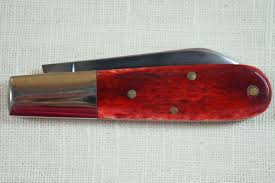Millard
F. Robeson founded the company, which bore his name in 1879 as a
cutlery-jobbing firm, operating from his home in Elmira, New York. Selling
knives was, at first, a sideline but business grew. Robeson’s first storage
area was his dresser drawer but, as additional space was needed, it overflowed
into the closet and underneath the bed. Upon returning from a business trip and
finding his cutlery inventory moved to the porch he agreed with Mrs. Robeson
that larger facilities were needed. They first came in the form of a new room
added to the house, next a new building adjacent to the house, and finally a
move to the New York town of Camillus.
After
leasing the cutlery works in Camillus, Robeson employed about three-dozen
workers making knives. Their tenure at this factory lasted about four years,
until 1898. Robeson had purchased an interest in Rochester Stamping Works and
it became Robeson Rochester Corporation. A move of the Robeson Cutlery
Company’s headquarters and manufacturing was made in Rochester and, about two
years later, in an additional location in Perry, New York.
In
1901, the trade name SHUREDGE was adopted for Robeson’s quality line of
cutlery. After Robeson’s death in 1903, his company remained although business
declined. In 1940, Saul Frankel, a Rochester businessman, purchased the then
bankrupt company. Frankel was not like Robeson, who had the knowledge and
expertise for manufacturing high-quality knives. But, he was an excellent
businessman and recognized his shortcomings. In order to seek success for his
company, Frankel sought out and hired Emerson Case to serve as Robeson’s vice
president and general manager. Case reorganized the company and became its
president in 1948.
In
1958, Robeson purchased Kinfolks Inc of Little Valley, New York, which just
happened to be Emerson Case’s former employer. From then until 1965, Robeson
produced Kinfolks brand knives in addition to its regular line, using many of
the same features and handle material.
Robeson
continued to make knives until 1965, the year that Emerson Case retired. Cutler
Federal Inc. at purchased the company about that time, and for the next six
years Robeson knives were made by Camillus Cutlery Co, but were shipped from
the Perry headquarters.
In
1971, the Ontario Knife Company bought Robeson and continued to offer Robeson
brand knives until 1977. In 1995, Ontario’s sister company Queen Cutlery
briefly returned the Robeson brand to production with a line of SHUREDGE
knives, followed by a line of POCKETEZE Robeson in 1999. Their blade etching
and other markings can readily identify these knives.
Many
Robeson knives were stamped with a variation of ROBESON CUTLERY CO or R.C. CO
from 1891 to 1940. From 1911 to 1940, the well-known stampings of ROBESON
SHUREDGE ROCHESTER and ROBESON SHUREDGE USA were used, with “Shuredge” in
script. From 1940 to 1965 the mark was ROBESON SHUREDGE USA in all block
letters. The last production years up to 1977 were marked ROBESON (pattern
number) USA. A few very early and rather late Robeson knives will be found
marked GERMANY, indicating their country of manufacture.
Robeson
was a very progressive company, introducing many innovative knives to the
market, particularly during the Emerson Case years. One line of knives popular
with collectors is those named POCKETEZE and identified by the shield bearing
the name. Registered in 1914, the trademark meant that the blade backs were
recessed below the knife handles, reducing their wear on pant pockets.
MASTERCRAFT, another Robeson trademark, was used on knives with bronze tang
inserts, and PERMALUBE knives had the bronze inserts placed in the back springs
instead. Etched on the blade of some Robeson knives are the words FROZEN HEAT,
indicating a cryogenic tempering process developed in 1950 by Emerson Case.
Finally, some later knives were produced with a tungsten carbide coated edge,
which Robeson called FLAME EDGE.
Older
Robeson knives were handled in green bone, brown bone and starting in the
1950s, a unique red bone referred to as strawberry bone. It was dropped from
the line in the 1960s in favor of plastic or composition handles of a similar
color. The last Robeson knives made until recent years had a darker Delrin handle.
Although
Robeson bone was and is quite popular, Robeson also handled knives in mother of
pearl, genuine stag, and the various composite handle materials. The shortage
of bone during World War II forced the company to use rough black composition
handle material.



No comments:
Post a Comment